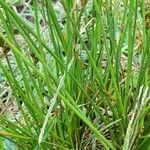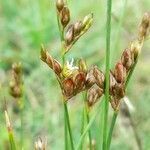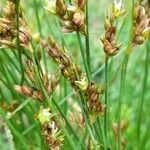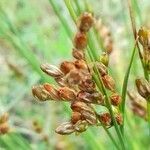Perennial, stiff erect clumps c, 60 cm high. stems rigid, bearing several basal sheaths and leaves. Leaves much < stems ± rigid, narrow, subterete, channelled; lowest sheaths light brown, sheaths of upper leaves reddish-purple with short truncate cartilaginous auricles. Inflorescence 4-10 cm long, with several ± rigid branches, and very slender bract not much > inflorescence. Flowers many, sessile, evenly spaced and often second along branches or more clustered. Tepals 3.5-4.5 mm long, all ± equal, acuminate, spreading from capsule at maturity. Stamens 6. Capsule long, ± = or slightly < tepals, ovoid, shortly mucronate, shining, light brown.




